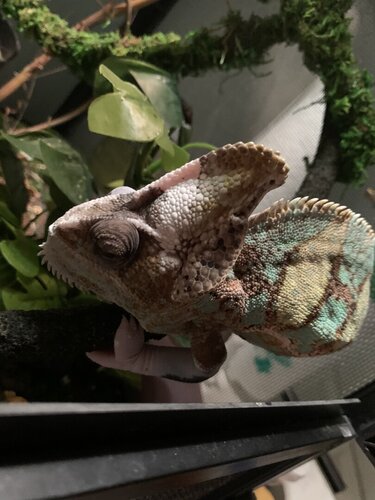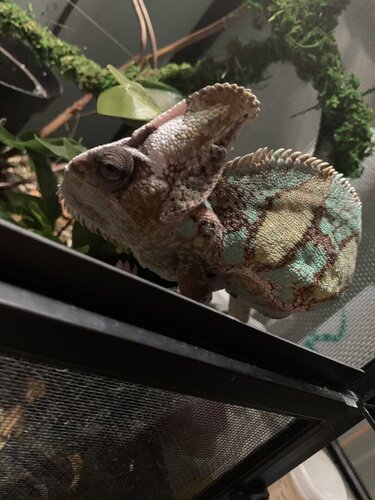Kaelahrae
Member
 I have a male piebald veiled chameleon. He is almost 8 months old. He has been in my care for a while now but my mother also has been taking care of him while I’m away.
I have a male piebald veiled chameleon. He is almost 8 months old. He has been in my care for a while now but my mother also has been taking care of him while I’m away.I almost never take him out of the cage unless for cleaning.
My chameleon has grown tired of gut loaded crickets and won’t take them anymore even when I dust them with calcium. So I have been feeding him super worms (i started this maybe a week ago but I do not know if it’s alright to calcium dust the worms. I use repti calcium without d3 most of the time but also have used reptivite for gut loading on veggies and fruits for my previous cricket routine,
The cage I do not remember the precise size but it’s also from zoo med? It’s all screen except for the bottom. I use usually 100 watt lighting with hangs above and have 2 different lights which I also forgot the name of because the enclosure is pretty tall. I turn off one of them every night as the directions on the light bulb container said to.
he has no physical deformities at the moment, but I can see he’s really shaky with his movements (not the leaf walk) and still gets around the cage.
He has had a lump on his throat before but it went away after a day in the picture I had just watered him. I believe the closest to his symptoms would be mbd. And because of the corona virus , I can’t take him to a vet and would greatly appreciate some help. How do I get him to eat crickets again? And what brands and dosage should I give my chameleon to help with the symptoms? I feel like a terrible chameleon mother but I try my hardest to keep up with the needs of my chameleon. I really need to know what can slow down the mbd or even help him get around the cage. PLEASE HELP I love him so much. And I work hard to try to keep him going. Please I want to help him in any way possible






